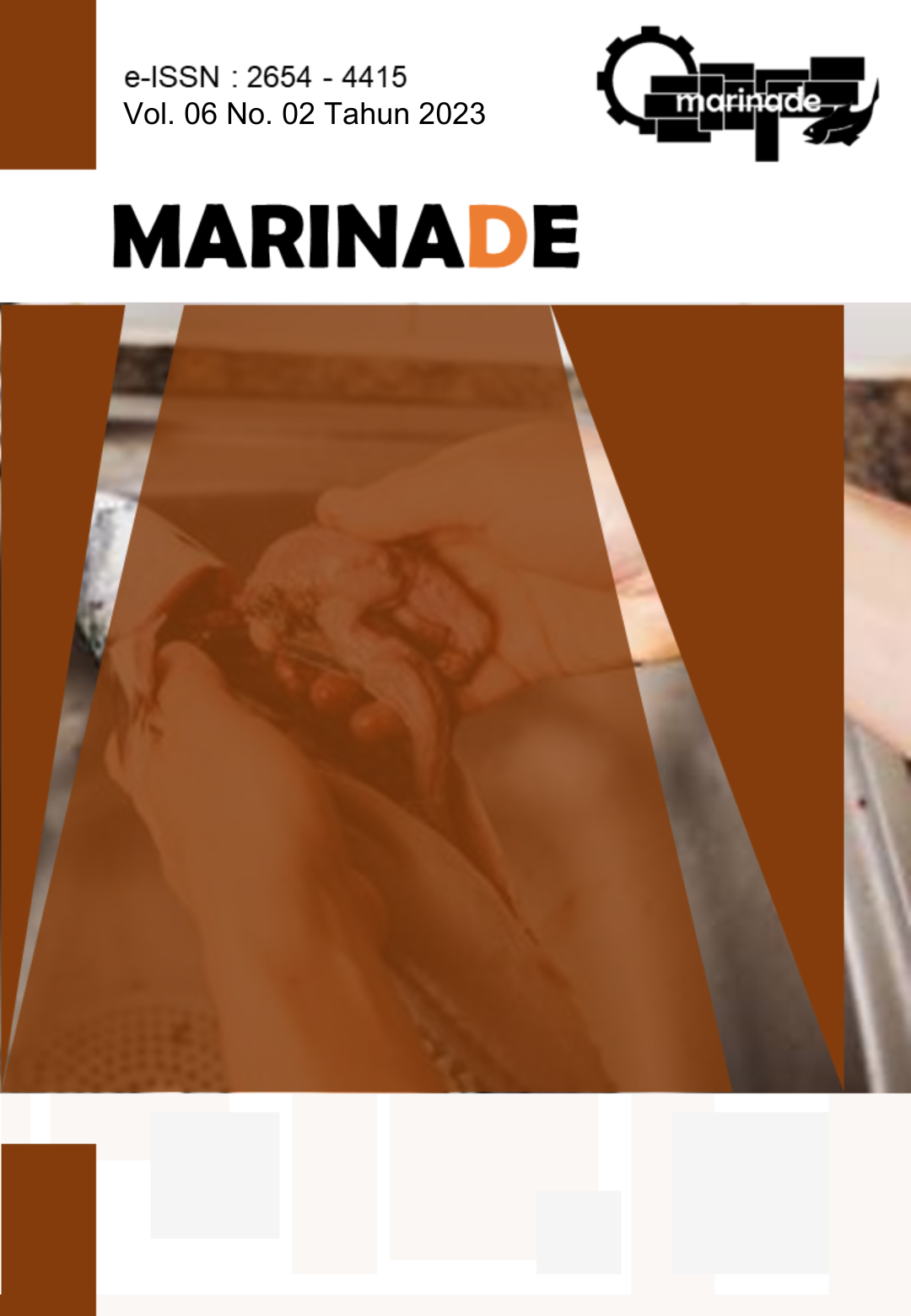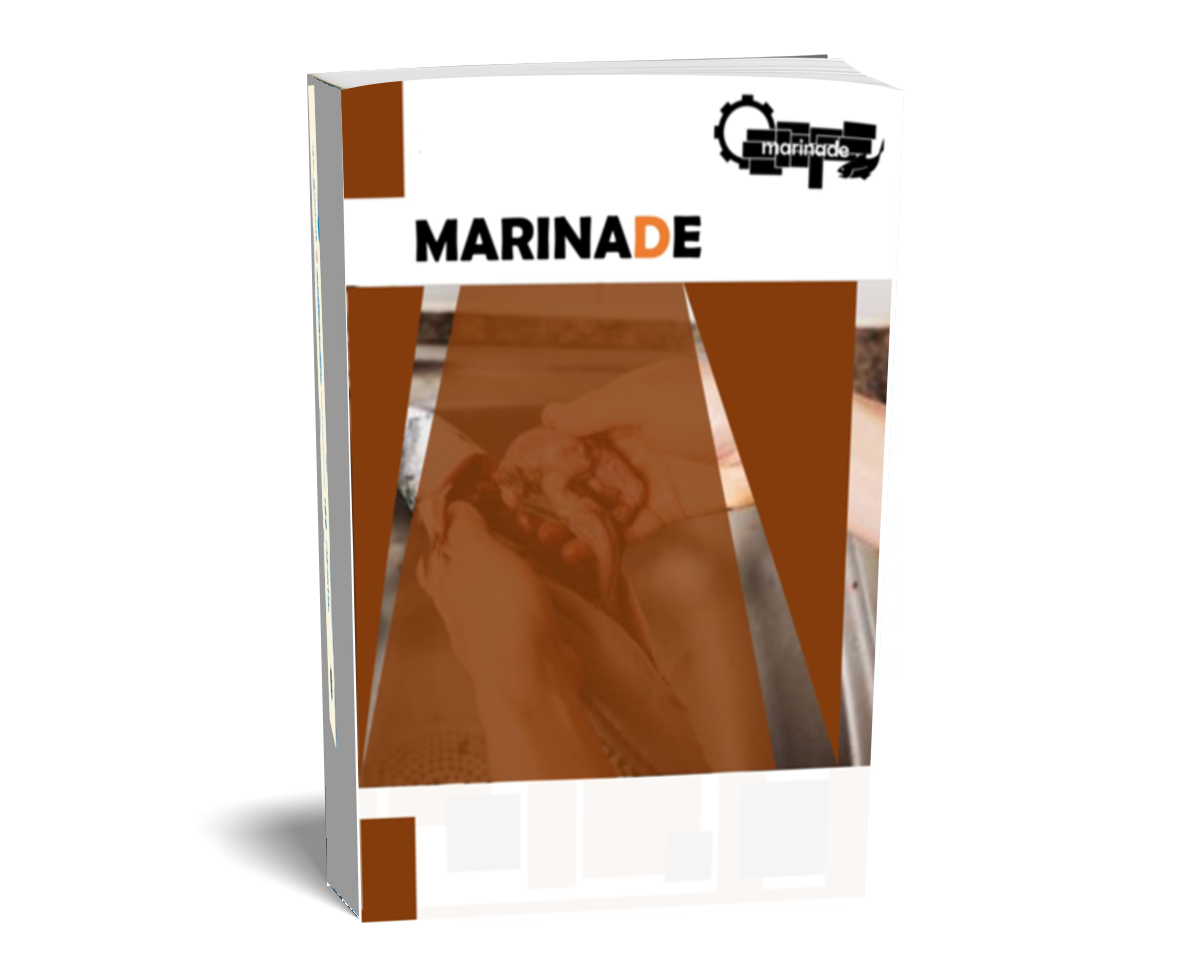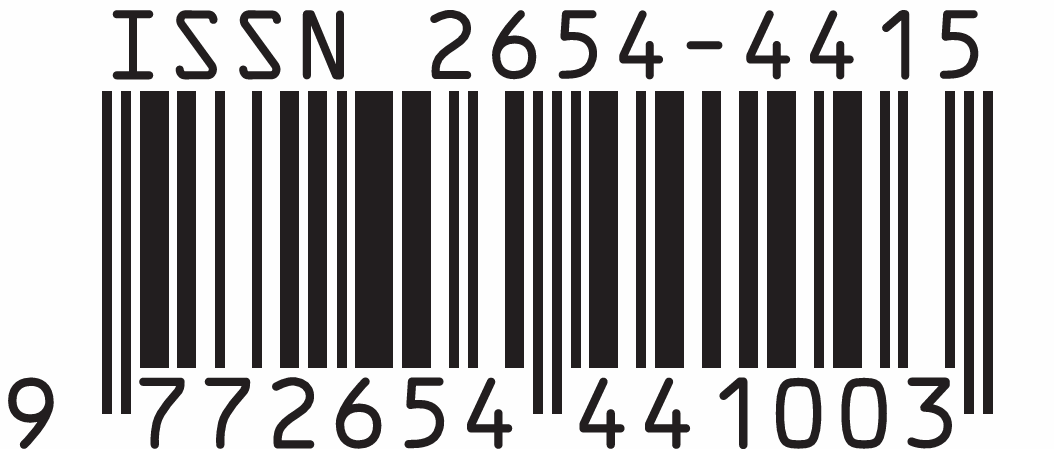ANALISIS FITOKIMIA DAN UJI TOKSISITAS EKSTRAK DAUN NIPAH (Nypa fruticans) DENGAN METODE BRINE SHRIMP LETHALITY TEST (BSLT)
DOI:
https://doi.org/10.31629/marinade.v6i02.5928Keywords:
Nypa fruticans, phytochemical analysis, thin layer chromatography, toxicityAbstract
Daun nipah (Nypa fruticans) banyak dimanfaatkan oleh masyarakat sebagai bahan baku kerajinan, olahan makanan, dan sebagai obat tradisional seperti obat sakit perut, dan obat penurun panas. Penelitian ini bertujuan untuk mengetahui kandungan senyawa aktif yang terkandung dalam daun nipah (Nypa fruticans) dan tingkat toksisitasnya. Dilakukan identifikasi senyawa aktif dengan uji fitokimia dan dilanjutkan dengan uji KLT. Ekstrak diuji tingkat toksisitasnya terhadap larva udang A. salina Leach. Data kematian A. salina Leach dianalisis dengan probit Microsoft Excel untuk mengetahui nilai LC50. Hasil analisis fitokimia menunjukan bahwa ekstrak daun nipah (Nypa fruticans) pelarut metanol mengandung senyawa aktif alkaloid, flavonoid, triterpenoid, saponin dan tanin. Ekstrak daun nipah (Nypa fruticans) pelarut klorofom adalah flavonoid dan triterpenoid. Hasil ini diperkuat dengan KLT menggunakan eluen terbaik, pada AA2 menghasilkan 15 spot. Hasil uji toksisitas menunjukkan bahwa nilai LC50 pada ektstrak daun nipah (Nypa fruticans) dengan pelarut metanol sebesar 100,34 ppm. Sedangkan nilai LC50 pada ektstrak daun nipah (Nypa fruticans) dengan pelarut klorofom sebesar 481,87 ppm.
Downloads
References
Harborne, J. B. 1987. Metode Fitokimia. Edisi ke-2. Padmawinata K, Soediro I, Penerjemah. Bandung: ITB. Terjemahan dari: Phytochemical Methods.
Imra, I., Tarman, K., Desniar, D. 2016. Aktivitas antioksidan dan antibakteri ekstrak nipah (Nypa fruticans) terhadap vibrio sp. Isolat kepiting bakau (Scylla sp.). JPHPI. 19(3): 241-25.
Jannah, M. 2014. Uji Toksisitas dan Fitokimia Ekstrak Kasar Metanol, Kloroform dan n-Heksana Alga Coklat (Sargassum vulgare) dari Pantai Kapong Pamekasan Madura. Skripsi. Universitas Islam Negeri Maulana Malik Ibrahim. Malang.
Lestari, Y., Ardiningsih P., dan Nurlina. 2016. Aktivitas antibakteri gram positif dan negatif dari ekstrak dan fraksi daun nipah (Nypa fruticans) asal pesisir sungai kakap Kalimantan Barat. Jurnal Kimia dan Kemasan. 5(4): 1-8.
Mangrove Information Center [MIC]. 2009. Nypa fruticans. Bali. Denpasar.
Nurjanah., Abdullah, A., Apriandi, A. 2011. Aktivitas antioksidan dan komponen bioaktif keong ipong-ipong (Fasciolaris salmo). Jurnal Pengolahan Hasil Perikanan Indonesia. 14(1): 22-29.
Quinn, R.J. 1988. Chemistry of Aqueous Marine Extract: Isolation Techniques in Bioorganic Marine Chemistry. Springer. 2: 1-41.
Rahmatullah, M., Saedak, Bachar, S. C., Hossain, A, l., Mamun, A., Montaha, Jahan, N., Chowdhury, M. H., Nasrin, N., Rahman, M. 2010. Brine Shrimp Toxicity Study of Different Bangladesh Medical Plants. American Eurasian Network for Scientific Information.
Rudianto., Putri, R.M.S., Apriandi, A. 2019. Aktivitas Antioksidan dari Tanaman "Beruas Laut" (Scaevola taccada), Jurnal Marinade. 02(1): 29-38.
Setyowati, W. A. E., Cahyanto, M. A. S. 2016. Kandungan kimia dan uji aktivitas toksik menggunakan metode BSLT (Brine Shrimp Lethality Test) dari ekstrak daun kersen (Muntingia calabura). Jurnal Kimia dan Pendidikan Kimia. 1(2): 41-47.
Sharo, N. M., Ningsih, R., Nasichuddin, A., Hanapi, A. 2013. Uji toksisitas dan identifikasi senyawa ekstrak alga merah (Eucheuma cottonii) terhadap larva udang artemia salina leach. Jurnal Alchemy. 2(3): 170-177.
Tomayahu R, Bialang N. Salimi YK. 2014. Identifikasi senyawa aktif dan uji toksisitas ekstrak daun binahong (Anredera cordifilia) dengan metode BSLT. Jurnal Fakultas MIPA. Universitas Negeri Gorontalo.
Vitalia, N., Najib, A., Ahmad, A.R. 2016. Uji Toksisitas Ekstrak Daun Pletekan (Ruellia tuberosa L.) dengan Menggunakan Metode Brine Shrimp Lethality Test (BSLT). Jurnal Fitofarmaka Indonesia. 3(1): 124-129.
Wijaya, H., Novitasari., Jubaidah, S. 2022. Perbandingan Metode Ekstraksi Terhadap Rendemen Ekstrak Daun Rambai Laut (Sonneratia caseolaris L. Engl). Jurnal Ilmiah Manuntung. 4(1):79-83.
Downloads
Published
Issue
Section
License
Copyright (c) 2023 Marinade

This work is licensed under a Creative Commons Attribution-NonCommercial-ShareAlike 4.0 International License.
You are free to:
- Share — copy and redistribute the material in any medium or format for any purpose, even commercially.
- Adapt — remix, transform, and build upon the material for any purpose, even commercially.
- The licensor cannot revoke these freedoms as long as you follow the license terms.
Under the following terms:
- Attribution — You must give appropriate credit, provide a link to the license, and indicate if changes were made . You may do so in any reasonable manner, but not in any way that suggests the licensor endorses you or your use.
- ShareAlike — If you remix, transform, or build upon the material, you must distribute your contributions under the same license as the original.
- No additional restrictions — You may not apply legal terms or technological measures that legally restrict others from doing anything the license permits.













